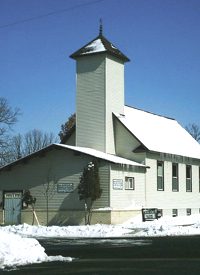
A statistical study of mosques in the United States shows that the number of Islamic houses of worship has increased 74 percent since 2000.
The study also showed that mosque leaders believe the United States is generally friendly to Islam, that attendance at weekly prayer has increased during that time, and that the faithful attending mosques has increased 30 percent.
Islam is growing in the United States.
The Numbers
The Hartford Institute for Religion Research conducted the study as part of its Faith Communities Today project. The study’s findings are significant given that the explosion in mosques occurred not only after the Muslim terrorist attacks of September 11, 2001, but also during a time when building new mosques, such as the one at Ground Zero in New York, has been a matter of controversy.
The key finding in the study is that “[t]he number of mosques and mosque participants continue to show significant growth.”
The US Mosque Survey 2011 counted a total of 2,106 mosques; as compared to the year 2000 when 1,209 mosques were counted — representing a 74% increase from 2000.
Nearly 50 percent of mosques are in six states: New York (257), California (246), Texas (166), Florida (118), Illinois (109), and New Jersey (109). The states with the largest number of mosques include that group plus Pennsylvania (99), Michigan (77), Georgia (69), and Virginia (62), which means that more than 62 percent of mosques are in just 10 states.
Three quarters of those mosques were established since 1980, the “vast majority” in cities. Greater New York City contains 192 mosques, with southern California at 120. They are followed by Chicago (90), Philadelphia (63), Detroit (62), the San Francisco Bay area (62), Atlanta (55), Northern New Jersey (53), Houston (42), and Dallas/Fort Worth (3).
The founding eras of the mosques seem to be connected to the massive influx of “refugees” and immigrants from the Muslim world, which began in earnest after Congress open the borders with the disastrous Immigration and Nationality Act of 1965.
Just five percent of mosques existed before 1960. During the next 10 years, that figure rose to six percent. But the numbers took off in the following decades. The percentage of mosques founded between 1970 and 1979 is 14 percent. In the next decade, it was 22 percent, and in the 1990s, 28 percent. Another 24 percent were founded between 2000 and 2009. Two percent have been founded since then.
The survey also reported that mosques are “extremely diverse institution[s]. Only 3% of mosques have only one ethnic group that attends that mosque. South Asians, Arabs, and African Americans remain the dominant groups but significant numbers of newer immigrants have arrived, including Somalis, West Africans and Iraqis.”
The vast majority of mosque attendees are South Asians, such as Pakistanis, at 33 percent, a number that remained constant since 2000. They are followed by Arabs, at 27 percent, and African Americans at 25 percent. After that, the numbers drop to four percent or less. Just two percent of mosque attendees are Europeans. A meager one percent are Latinos and white Americans.
The number of those attending mosques has also increased significantly, the survey reported. In 2000, some two million Muslims attended mosques. Now, 2.6 million do, a 30-percent increase. Since 1994, when just 500,000 Muslims attended mosques, the number has increased 420 percent.
The average attendance of Muslims at weekly prayer increased from 292 in 2000 to 353 in 2011, about 21 percent. The increase since 1994 is 135 percent.
Muslims Feel at Home
Despite the Sept. 11 attacks and their aftermath, Muslims apparently feel at home in United States.
The mosque survey showed mosque leaders do not think the United States is inhospitable to Islam and Muslims. The survey asked whether mosque leaders think “American society is hostile to Islam?”
“Whereas in 2000 — before the tragedy of 9/11 — over half of mosque leaders agreed that American society is hostile to Islam [56 percent agreed while 44 percent disagreed], in 2011 only one-fourth (25%) agreed with that statement,” the survey reported. “ In fact, half of all mosque leaders disagree with the statement that American society is hostile to Islam.”
Based on comments during the Survey interview, most mosque leaders viewed the statement as too blanket, and they would say that the majority of America people are not hostile to Islam. Ignorance of Islam is the real problem in the eyes of many mosque leaders. They would mention some media outlets and certain Islamaphobic groups as being the real culprits in inciting hostility to Islam, but they add that they have been treated well by the people in their own area. Some mentioned incidents after 9/11 when people came forward to offer their support. Surprisingly, even mosque leaders who were embroiled in contentious neighborhood battles at the time of the interview recognized the many good people in the area, and therefore chose to disagree with the statement that American society is hostile to Islam.
As well, mosque leaders don’t seem to be concerned about the issue of moral decay of American society. “The majority of mosque leaders (55%) disagree that America is immoral,” the survey reported.
Again this is a marked shift from 2000, when the majority of mosque leaders [56 percent] agreed with that statement. In 2011 only about one-fourth [24 percent] agreed that America is immoral.”
Why the Explosion?
The question is why there has been a rapid increase in mosque building, despite the controversies about mosques at Ground Zero and in Tennessee. One reason is the rise in Muslim immigration, as shown by the Refugee Resettlement Watch website, which publishes official charts on the matter from the federal government.
Many of those immigrants landed here in the guise of “refugees.”
The number of Somalis who have flooded the United States is a cause of concern to many. Between 1983 and 1993, 4,413 Somalis landed on American shores. By 2003, the country admitted 42,017 Somalis, with a high of 6,000 in 2000.
But the numbers skyrocketed even after that. The number for 2004 through 2011 is 54,947, broken down as follows:
2004: 12,814
2005: 10,101
2006: 10,330
2007: 6,958
2008: 2,523
2009: 4,189
2010: 4,884
2011: 3,148
Thus, since 1983, according to the website, 96,964 Somalis have entered the United States, a figure that seems disproportionately high for a nation of under 10 million people.
The reason the numbers dropped in 2008, the website reported, is that federal refugee officials began DNA testing those who claimed to have family in the United States. The officials learned that the immigrants and their anchors in the United States lied about being related. A report in the Wall Street Journal documented the chicanery among the “refugees” trying to join their “families” in the United States. “We had high rates of fraud everywhere, except the Ivory Coast,” an official told the newspaper.
The consequences of the Somali deluge have not been good. As The New American reported today, 23 Somalis are on trial in Tennessee for running a sex slavery ring. They operated the criminal enterprise for a decade before federal, state, and local authorities stopped them. Additionally, numerous Somalis seeking welfare benefits have moved to Lewiston, Maine.
But Somalis aren’t the only immigrants entering the country to claim refugee status. Between 1983 and 2010, the U.S. government admitted more than 175,000 refugees from turbulent Iran and war-ravaged Iraq, the records show.
Photo: Islamic Society of Northern Wisconsin Mosque in Altoona, Wisconsin


